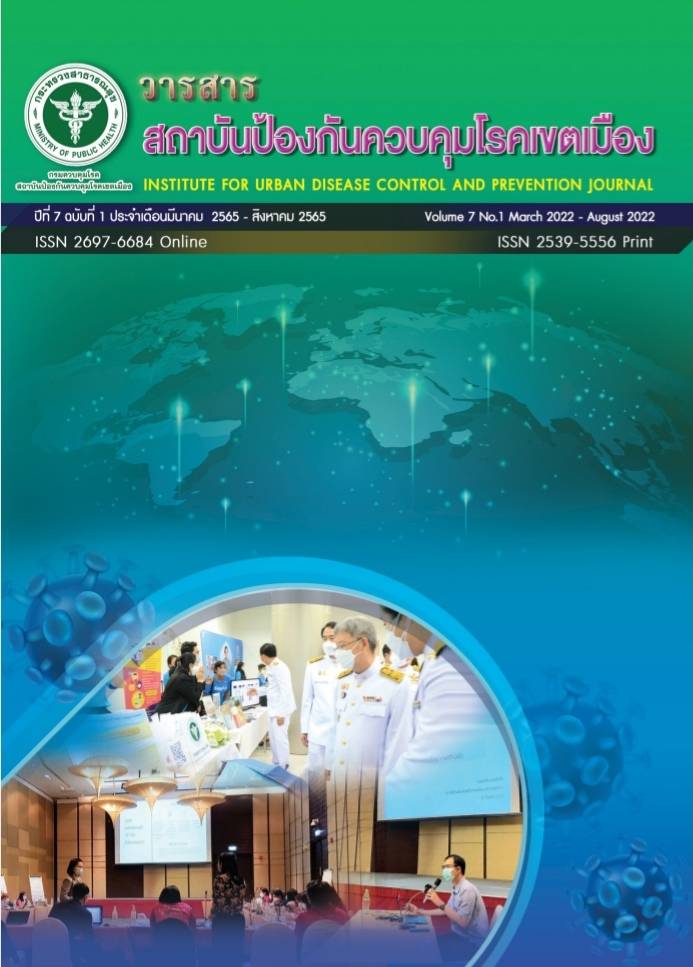การพัฒนาระบบการเบิกจ่ายทรัพยากรกลุ่มบริหารเวชภัณฑ์และโลจิสติกส์ ในช่วงการระบาดของโรคติดเชื้อไวรัสโคโรนา 2019
Main Article Content
บทคัดย่อ
จากสถานการณ์การระบาดของเชื้อไวรัสโคโรนา 2019 ในประเทศไทย พบผู้ติดเชื้อสะสมมากกว่า 1 ล้านราย และมีจำนวนผู้ติดเชื้อรายใหม่เพิ่มขึ้นมากกว่า 2 หมื่นรายต่อวันเป็นสาเหตุให้ทุกหน่วยงานจำเป็นต้องมีการปรับตัว ในการทำงานเพื่อให้สอดรับกับสถานการณ์นี้ กลุ่มงานบริหารเวชภัณฑ์และโลจิสติกส์ หนึ่งในกลุ่มงานของสถาบัน ป้องกันควบคุมโรคเขตเมือง จึงได้พัฒนาระบบการเบิกจ่ายทรัพยากรจากการเบิกจ่ายโดยกรอกแบบฟอร์มการเบิกจ่าย เปลี่ยนเป็นแบบฟอร์มการเบิกจ่ายออนไลน์มีวัตถุประสงค์เพื่อให้เจ้าหน้าที่ได้รับความสะดวกรวดเร็วในการเบิกทรัพยากรเพื่อลงพื้นที่ออกตรวจหาเชื้อเชิงรุก และเป็นการเว้นระยะห่าง ลดการสัมผัสระหว่างการรอจัดทรัพยากรอีกด้วย และนอกจากนี้ ทางกลุ่มงานบริหารเวชภัณฑ์และโลจิสติกส์ได้สำรวจความพึงพอใจของเจ้าหน้าที่ผู้เบิกทรัพยากรผ่านแบบฟอร์มออนไลน์นี้ และต้องการเก็บข้อมูลปัญหาความผิดพลาดในการเบิกจ่ายทรัพยากรในช่วงวันที่ 1 กรกฎาคม-15 สิงหาคม 2564 อีกด้วย โดยแบบฟอร์มออนไลน์ที่จัดทำขึ้นนี้ เป็นรูปแบบเอกสารกูเกิล ฟอร์ม (Google form) เป็น Platform โดยข้อคำถาม แบ่งออกเป็น 7 ส่วน ส่วนที่ 1 คือ หน่วยงานที่เบิก ส่วนที่ 2 คือ วันที่ต้องการรับของและสถานที่จัดส่ง ส่วนที่ 3 คือ อุปกรณ์ที่ใช้บ่อย เป็นต้น ส่วนที่ 4 น้ำยาฆ่าเชื้อต่างๆ ส่วนที่ 5 ถุงซิปและถุงขยะ ส่วนที่ 6 อุปกรณ์ฉีดยา ส่วนที่ 7 คือ ชื่อผู้ลงข้อมูล และมีรายการทรัพยากรของที่มีในปัจจุบันพร้อมรูปภาพ ประกอบในบางรายการที่มีลักษณะพิเศษ เมื่อมีผู้ลงข้อมูลการเบิกทรัพยากรในแบบฟอร์มนี้ ข้อความรายการเบิกทรัพยากร ทั้งหมด จะแจ้งเตือนผ่านทาง Application Line ของกลุ่มงาน เพื่อให้เจ้าหน้าที่จัดรายการเบิกเหล่านั้น ไว้ล่วงหน้า และส่งมอบตามเวลานัดหมายได้ทันที อีกทั้งยังมีการเก็บข้อมูลผ่าน Google sheet เพื่อให้เจ้าหน้าที่สามารถ รวบรวมและวิเคราะห์ข้อมูลได้โดยง่าย ทำให้ลดการใช้เจ้าหน้าที่ในการลงข้อมูลอีกด้วย
ผลการสำรวจพบว่า ในการเบิกทั้งหมด 427 ครั้ง พบผู้เบิกกว่า 62 คน มีความพึงพอใจในการใช้แบบฟอร์มการเบิก ทรัพยากรออนไลน์เป็นอย่างมากในทุกๆห้วข้อการประเมินและพบว่ามีความพึงพอใจสูงสุดในหัวข้อความพึงพอใจโดยรวมซึ่ง อยู่ที่ร้อยละ 66.1 และพบว่ามีความคลาดเคลื่อนในการเบิกจ่ายทรัพยากรทั้งหมด 14 ครั้ง คิดเป็นร้อยละ 3.28 ทางกลุ่มงานจึงได้เร่งหาการแก้ไขสำหรับข้อผิดพลาดต่างๆ อีกทั้งยังจะได้พัฒนาต่อยอดออกไปให้ครอบคลุมในรายการเบิกที่มีเพิ่มขึ้นมา และลดการใช้กระดาษ (Paperless) ในการเก็บข้อมูล
Article Details

อนุญาตภายใต้เงื่อนไข Creative Commons Attribution-NonCommercial-NoDerivatives 4.0 International License.
บทความที่พิมพ์ในวารสารสถาบันป้องกันควบคุมโรคเขตเมือง ถือว่าเป็นผลงานวิชาการ งานวิจัยและวิเคราะห์ ตลอดจนเป็นความเห็นส่วนตัวของผู้เขียนเอง ไม่ใช่ความเห็นของสถาบันป้องกันควบคุมโรคเขตเมือง หรือคณะบรรณาธิการแต่ประการใด ผู้เขียนจำต้องรับผิดชอบต่อบทความของตน
เอกสารอ้างอิง
WHO Coronavirus Disease (COVID-19) Dashboard [Internet]. World Health Organization. 2020[cited 2021 Aug 27]. Available from: https://covid19.who.int/?gclid=Cj0KCQjw2or8BRCNARIsAC_ppyaOw_T8suGSIDPmbBa6-XQ882DiynyAE-hY-C9lajmYej5ksz-uIGkaAuIiEALw_wcB.
ศูนย์ปฏิบัติการภาวะฉุกเฉิน กรมควบคุมโรค. รายงานสถาณการณ์โรคติดเชื้อไวรัสโคโรนา 2019.(23 สิงหาคม 2564).นนทบุรี: กระทรวงสาธารณสุข; 2564.)
World Health Organization. Coronavirus disease (COVID-2019) situation reports [cited 2020 July 15]. Available from: http:// www.who.int/Home/Emergencies/Diseases/ Coronavirus disease 2019/Situation reports
Management of personal protective equipment and N95 respirator for covid-19 response. Journal of health science 2021; 30(1):137-150.
Paitool K., Atsawaranon K.,Jittimanee S. Imported cluster of COVID-19 in Thai returnees from Japan in a State Quarantine, Thailand: epidemiological and serological investigation. Institute for Urban Disease Control and Journal 2020; 5(2): page19.
Garcia Godoy LR, Jones AE, Anderson TN, Fisher CL, Seeley KML, Beeson EA, et al. Facial protection for healthcare workers during pandemics: a scoping review. BMJ Glob Health [Internet]. 2020 [cited 2020 Jul10]:5(5)::e002553. Available trom: https://www.ncbi.nlm.nih.gov/pinc /articles/PMC7228486
Agalar C, Ozturk Engin D. Protective measures for COVID-19 for healthcare providers and laboratory personnel. Turk J Med Sci 2020; 50(3):578-84.


